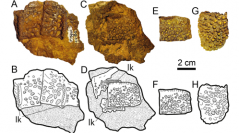

 Comptes Rendus Palevol
16 (1) - Pages 12-26
Comptes Rendus Palevol
16 (1) - Pages 12-26We describe crocodylian remains from the Early Miocene (MN4) site of Els Casots (Subirats, Vallès-Penedès Basin, NE of the Iberian Peninsula). Referral to Diplocynodon (Alligatoroidea: Diplocynodontidae) is justified by several cranial and postcranial features, including: (1) the subequal and confluent alveoli of the maxilla (fourth and fifth) and dentary (third and fourth); (2) the position of the foramen aëreum on the quadrate; (3) the small and ventrally reflected medial hemicondyle of the quadrate; (4) the distinct dorsoventral step on the frontal; and (5) the bipartite ventral osteoderms. Multiple morphological features are consistent with an attribution to Diplocynodon ratelii, previously known from the Early Miocene (MN2) of France, and discount an alternative attribution to other species of the genus, including Diplocynodon ungeri from the Middle Miocene (MN5) of Austria. The described material from Els Casots is smaller in size than the French material of D. ratelii, possibly reflecting an earlier ontogenetic stage. The described remains constitute the first report of D. ratelii and the youngest record of Diplocynodon in the Iberian Peninsula, where only Diplocynodon muelleri and Diplocynodon tormis have been previously reported. The presence of Diplocynodon further supports the lacustrine depositional environment previously inferred for Els Casots and also indicates a relatively high temperature.
Fossil crocodiles, Alligatoroidea, Diplocynodon ratelii, Cranial anatomy, Catalonia, Spain